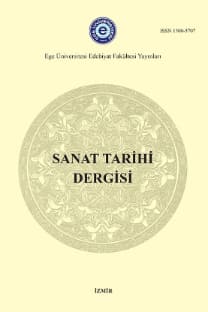Manisa Ulu Cami ve Medresesi’nde Yeni Keşfedilen Devşirme Taş Eserler
Manisa, Ulu Cami, Taş eser, devşirme, bizans, Manisa Ulu Camii, S-Sarmal Volütlü Başlıklar, Cista.
Newly Discovered Spolia in Manisa Ulu Mosque and Madrasa
Manisa Roman, Byzantine, Spolia, Ulu Cami, Manisa Ulu Mosque, Capitals with S-Spiral Volutes, Cista, Manisa Grand Mosque,
___
- Acun, H. (1999), Manisa’da Türk Devri Yapıları, Ankara: TTK
- Aydın, A. (2013), Erken Hıristiyanlık - Bizans Dönemi Mimari Elemanlarının /Süslemelerinin Kataloğu ve Değerlendirilmesi, Silifke Müzesi Taş Eserler Kataloğu Heykeltıraşlık ve Mimari Plastik Eserler (ed. S. Durugönül), 183-315.
- Barsanti, C. (2016), Un capitello ionico ad imposta di epoca protobizantina reimpiegato nella Ulu Camii di Manisa, “A mari usque ad mare” Cultura visuale e materiale dall’Adriatico all’India Scritti in memoria di Gianclaudio Macchiarella, Ca’Foscari, 49-62.
- Başaran, C. (1997), Kyzikos Korinth Başlıkları, Türk Arkeoloji Dergisi, XXXI, Ankara: 1-52.
- Başaran, C. (1999), Anadolu Kompozit Başlıkları, İstanbul
- Dennert, M. (1997), Mittelbyzantinische Kapitelle: Studien zu Typologie und Chronologie. Asia Minor Studien 25, Bonn: Dr. Rudolf Habelt GMBH.
- Doğan, M. U. (2007), Magnesia ad Spylum, Arkeoloji, Topografya ve Tarihi Coğrafya İncelemesi, (Yayımlanmamış Yüksek Lisans Tezi), Dokuz Eylül Üniversitesi Sosyal Bilimler Enstitüsü Klasik Arkeoloji Anabilim Dalı, İzmir.
- Ermiş, Ü. M. (2004), İzmir ve Manisa Çevresindeki Templon Arşitravları, Bilim Eşiği 1, Sanat Tarihinde Gençler Semineri, İstanbul: 1 - 04 Eylül, 76-98.
- Hasol, D. (1998), Ansiklopedik Mimarlık Sözlüğü, İstanbul.
- Heilmeyer, W. D. (1970), Korinthische Normalkapitelle. Studien zur Geschichte der Römischen Architectur decoration, Römische Abteilung Ergänzungshefte 16, Heidelberg.
- Hermann, J.J. - Tykot, R.H. (2009), Some Products From The Dokimeion Quarries: Craters, Tables, Capitals, And Statues, Proceedings of the 7th International Conference of Association for the Study of Marble and Other Stones in Antiquity Thassos 15-20 september 2003, (ed. Y. Maniatis), BCH Supplément 51, Athens: 59-75.
- İdil, V. (1979), Stratonikeia’da (Eskihisar) Kentin Kuzey Kapısının İç Kesimindeki Korinth Başlığı, VIII. Türk Tarih Kongresi, Ankara: 477-486.
- İdil, V. (1984), Anadolu’da Roma İmparatorluk Çağı Korinth Başlıkları, Anadolu/Anatolia, XX, 1-49.
- Kautzsch, R. (1936), Kapitellstudien. Beiträge zu einer Geschichte des Spätantiken Kapitells im Osten vom vierten bis ins siebente Jahrhundert. Studien zur Spätantiken Kunstgeschichte, 9, Berlin, Leipzig.
- Kramer, J. (1994), Korinthische Pilasterkapitelle in Kleinasien und Konstantinopel, Istanbuler Mitteilungen; Beiheft 39, Tübingen.
- Niewöhner, P. (2007), Byzantinische Steinmetzarbeiten aus dem Umland von Milet, Anadolu ve Çevresinde Ortaçağ 1, Ankara: 1-28.
- Ötüken, Y. (1996), Forschungen im Nordwestlichen Kleinasien: Antike und Byzantinische Denkmäler in Der Provinz Bursa, Istanbuler Mitteilungen, Beiheft 41, Tübingen.
- Pace, T. D (2014), Typology of Roman Locks and Keys. Southwestern Baptist Theological Seminary, (Unpublished PhD Thesis), Texas.
- Strzygowski, J. (1902), Das griechisch-kleinasiatische Ornament um 967 n. Chr., Wiener Studien 24, 443-447.
- Şimşek, Z. (2011), Allianoi Roma Dönemi Mimari Bezemeleri, (Yayımlanmamış Yüksek Lisans Tezi), Trakya Üniversitesi Sosyal Bilimler Enstitüsü Arkeoloji Anabilimdalı, Edirne.
- Thür, H. (1989), Das Hadrianstor in Ephesos. Forschungen in Ephesos; Band. 11.1, Wien: Verlag der Österreichischen Akademie der Wissenschaften.
- Uluçay, Ç. , Gökçen, İ. (1939), Manisa Tarihi, İstanbul: Manisa Halkevi Yayınları
- Weigand, E. (1914), Baalbek und Rom, die Römische Reichskunst in ihrer Entwickelung und Differenzierung, Jahrbuch des Kaiserlich Deutschen Archäologischen Instituts, XXIX, Berlin: 37-91.
- Yaraş, A., Şimşek, Z. (2011), Allianoi ‘S’ Kıvrımlı Sarmallı Sütun Başlıkları, Mediterranean Journal of Humanities, I/2, 225-236.
- ISSN: 1300-5707
- Yayın Aralığı: 2
- Başlangıç: 1982
- Yayıncı: Ege Üniversitesi, Edebiyat Fakültesi
MİLLİ MİMARİ AKIMLARIN ÇAĞDAŞ TASARIMDA OKUNMASI: CITY’S NİŞANTAŞI ALIŞVERİŞ MERKEZİ ÖRNEĞİ
Emre KURUÇAY, Hayrun Nisa KURUÇAY
SANAT VE EDEBİYAT GAZETESİNİN SANAT YAZILARI ÜZERİNE BİR DEĞERLENDİRME
İslam Sanatında Kantûrus (Kentaur) Tasviri
1957 Sao Paulo Bienali Türkiye Sergisi
Sinan’ın Camilerinde Yapı Mühendisliği Sanatı
Muhammed Emin AKYÜREK, Gülçin KAHRAMAN
Mardin İdadi Mektebi’nin Mekansal Ve İşlevsel Değişimi Üzerine Bir Değerlendirme
İzzettin KUTLU, Saide Selin ERAY
Muğla Evlerindeki (Merkez Menteşe İlçesi) El Biçimli Kapı Tokmakları
Kalemişi Süslemeli Cami Geleneğinin Devamı: Güzelyurt Tahtalı Köyü Camii (Denizli-Çameli)
19. Yüzyıl Sonu İstanbul’unda Bir “Arka Plan” Mimarı: Annibale Rigotti
